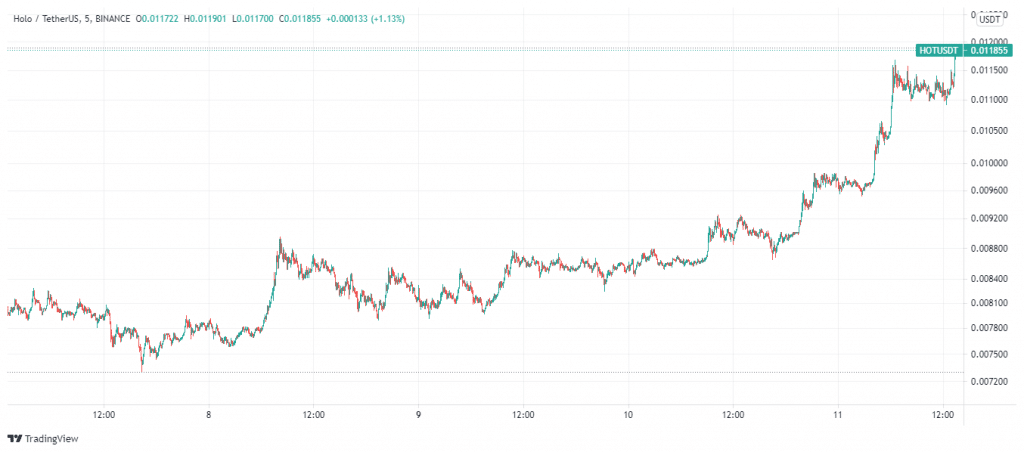Holo Price Up By 23.54% – Time To Buy HOT?
Please note that we are not authorised to provide any investment advice. The content on this page is for information purposes only.
Holochain is a very exciting crypto project that has since been dubbed the blockchain-killer. According to the development team, Holochain wants to change how we think about distributed ledger technology (DLT). This unconventional position has seen several investors keen to buy HOT.
In the last 24 hours, HOT has posted gains in double digits and shown resilience in a fast-paced crypto market. This article dissects what Holochain aims to achieve and if this may be a great time to buy HOT.
Holochain: Enabling An Agent-Centric System

Launched in March 2020, Holochain is a peer-to-peer (P2P) distributed platform that seeks to be an alternative to blockchain technology as we know it. To do this, Holochain enables a switch from the data-dependent blockchain to an agent-centric system.
Each agent keeps a private fork, stores and manages data in a limited manner on the blockchain with a distributed hash table.
This helps it to deal with the scalability issues that have beset several blockchain platforms. Decentralized applications (dapps) hosted on the Holochain platform get to do more with fewer resources than is normally needed in traditional blockchain platforms.
As introduced by Bitcoin, Blockchain technology works by storing data in cryptographic hashes on a distributed network.
This demands that each node on the web keeps a full copy of the blockchain in order to validate transactions and maintain the integrity of the network. Although this has been a major strength, it has also presented issues.
One of the most discussed in the emerging space is the scalability issues caused by the demand for each node to have a full copy of the network.
As the amount of data on the network increases, it becomes more difficult to validate transactions on the network faster. These slow lag times spiral into high network fees.
Holochain solves this issue by taking away the demand for each validator node on its network to have a full copy of its entire blockchain.
Instead, each validator node keeps a separate node that interacts with the node’s unique cryptographic key. This way, if a node goes offline, it creates a chain fork without impacting the public chain. It does not affect the larger network as the platform continues validating transactions.
This method also comes with another major benefit, and that touches on its impact on the environment. Popular cryptocurrencies like Bitcoin and Ethereum have been criticized for their dependence on the ancient proof-of-work (PoW) consensus algorithm.
The mining protocol demands that miners compete for block rewards has come under severe criticism after Bitcoin energy demands were greater than several small countries.
Holochain can address this environmental question. This is because its system of not requiring validator nodes to store a full copy of its blockchain allows them to use only a small percentage of their bandwidth in validating transactions.
Also, there are no special mining rigs needed for the Holochain network. This takes away excessive demand for electricity as validating agents can verify transactions with the standard electricity used in normal computers.
HOT Rallying With The Broader Crypto Market
Despite the Holochain network’s radical approach, its governance token HOT has been tied to Bitcoin’s price action. As ideal as its solutions are, it still operates in a universe controlled by the 9 million percent crypto asset.
This has seen its price rise and ebb with the popular digital asset. Meanwhile, its value proposition is interesting, and investors are looking to buy HOT as it could be the bedrock of a new blockchain protocol.
Price-wise, volatility has been its greatest enemy. It has had little impact in the market and only saw its value pick up steam this year. It began the year at $0.000802 and has not looked back ever since, rising to a first-year gap of $0.01814 on March 30.
This served as a stepping stone for HOT, and it peaked in early April, trading at $0.02848. This meteoric rise saw HOT rally more than 5,000% in a single month. However, volatility saw its gains eroded as it dipped 50%, entering the market crash on a downtrend. This pushed its price action further, bottoming out at $0.004785 on July 19.
HOT is pushing against the bearish current and has rallied 23.54% in the last 24 hours. It is up to $0.01128, and this may be a good spot to buy HOT before it makes a new all-time high (ATH).
HOT Technical And Fundamental Analysis
HOT’s bullish streak is obvious on the trading chart as its technicals are quite strong.
On the trading chart, HOT is trading above the 20-day moving average (MA) support price of $0.006902 and does not look like it would be coming down anytime soon. This could see it make new support at $0.009775 in the event of a severe market downturn.
Its relative strength index (RSI) is also high, currently standing at the overbought region of 89.79. This shows that more investors want to buy HOT.
Market experts also believe that HOT is not yet done. According to Wallet Investor, HOT will rally to $0.0171 by the end of the year and surge to $0.0526 in the next five years. Digital Coin pegs the HOT price at $0.0163 and a five-year forecast at $0.037.
Holochain is an outlier and is rapidly redefining the way business should be done in the near future. Investors who buy HOT could end up making massive returns in the event of widespread adoption.





